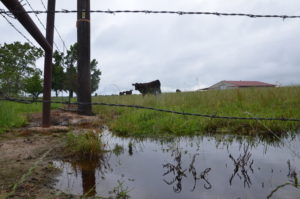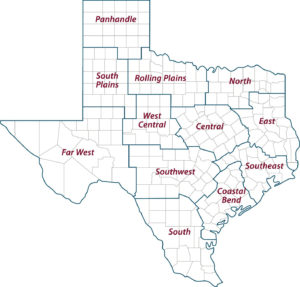Rainy weather helps soil moisture levels
Texas Crop and Weather Report – Nov. 30, 2022
Recent rainy weather improved soil moisture conditions for many wheat and cool-season forage producers, but most of Texas remains below normal rainfall, according to Texas A&M AgriLife Extension Service experts.
John Nielsen-Gammon, Ph.D., state climatologist in the Texas A&M College of Arts and Sciences Department of Atmospheric Sciences, said parts of the state received beneficial rainfall over the past week and that cooler temperatures will help soils retain the moisture.
“The Thanksgiving weekend was a lucky shot,” he said. “As late as Tuesday, the computer models were saying that the storm could move through quickly and miss us, could stall in an ideal spot, or slide south. It ended up stalling in an ideal spot, producing a broad swath of precipitation across the middle of the state.”
Midland to San Angelo, Corpus Christi, McAllen and northeastern areas of the state received good rains that should provide decent soil moisture for the rest of the year, Nielsen-Gammon said. The largest totals for the week were in southeastern Texas.
Port Arthur received 5.95 inches and Baytown 5.43 inches. Elsewhere in the state, Carthage in northeast Texas recorded 5.06 inches, Santa Anna recorded 4.1 inches, and several stations near Brownsville recorded 3-4 inches.
But the outlook for the rest of the winter is dry, he said. There is around a two-out-of-three chance of below-normal rainfall for December through March, with the worst odds of receiving rainfall toward the southern and western parts of the state.
Temperatures will also be above normal most of the time, but there will be cold air farther north waiting to blow into the state occasionally, he said. The effect of La Niña tends to wear off by April or so, but more importantly, La Niña itself will probably dissipate by then.
“It’s about time; this is the third La Niña winter in a row,” he said. “It’s time to be hopeful that the pendulum will swing in the other direction so that an El Niño might develop over the summer and tilt the odds in favor of a wet winter next time around.”
Rainy weather improves regional conditions
Reagan Noland, Ph.D., AgriLife Extension agronomist, San Angelo, said the recent storm systems delivered good moisture throughout most of the region. Most locations received 2-3 inches, with some catching up to 4 inches of rainfall.
Noland said the moisture will help planted wheat and any cover crops planted by producers in the region.
“Everyone got rain. It was slow and was able to soak in, and the winter crops will certainly benefit from the moisture,” he said. “We are still in a deficit for the year, but we are in much better shape than two months ago.”
Much of the Rolling Plains received 1-2 inches of rain that has improved soil moisture conditions in wheat fields, said Emi Kimura, Ph.D., AgriLife Extension agronomist, Vernon. The rains helped moisture conditions but hindered the region’s cotton and peanut harvests.
Kimura said the moisture should sustain the wheat crop through December but that additional rains will be needed into January and February. Most producers utilize the wheat for grazing and decide in late February whether to continue utilizing fields as forage or taking the crop to grain.
“A lot of producer decisions regarding wheat will come down to weather and grain prices going forward,” she said. “But so far, so good. At least there is some optimism. It was depressing to talk about any crop a few months ago because it was so dry.”
Larry Stein, Ph.D., AgriLife Extension horticulture specialist, Uvalde, said much of the Winter Garden region of Texas received much-needed moisture from multiple precipitation-producing systems over the last 10 days. Recent precipitation started with days of drizzly conditions followed by a good rain.
Much of the region had not received significant moisture since the August rains that dried quickly under triple-digit temperatures and high winds, Stein said. Water tank and pond levels remained a concern, but producer optimism about wheat and winter forages is higher.
Stein said the moisture will help the spectrum of plant life from trees and landscape plants to pastures and crops in the field. Many producers planted wheat and ryegrass before the rainfall and that the moisture could influence future plantings.
“It was as dry as I have ever seen it after that August rain,” he said. “It dried out so quickly and was very dry and hot. It’s no longer powder dry. People talk about getting a million-dollar rain, well this one was probably a billion-dollar rain.”
AgriLife Extension district reporters compiled the following summaries:
CENTRAL
The district experienced below-normal temperatures along with rainfall over several days. Soil moisture levels were adequate. Stock tanks caught substantial amounts of water to bring levels back to comfortable levels. Fieldwork was limited due to widespread rains. Early planted oats and wheat were off to a poor start but looked very good following the rain. Wheat planted in the last three weeks was slow to germinate and emerge due to cold soil conditions. Livestock pastures looked very good with the green emergence of the cool-season annuals, but producers were still supplementing animal diets. Livestock were in fair condition.
ROLLING PLAINS
The district received 0.5-4 inches of slow, soaking rain with very little runoff. Overall conditions were improving. Recent rains greatly increased topsoil and subsoil moisture. Wheat conditions were poor in some areas but were improving. Rangeland and pasture conditions should improve with warmer days. Cattle diets were being supplemented with hay and cake, and few cattle were on wheat fields. Remaining cotton was in poor condition.
COASTAL BEND
Rainfall amounts ranged from 1.5-4 inches. This rain improved soil moisture conditions and should benefit farmers and ranchers. Winter pastures should come alive with some sunny days. Fieldwork was halted due to rain. Livestock were doing well. Pecan harvest continued, but rainy conditions made harvest difficult.
EAST
The district received large amounts of rain. Ponds and creeks were filling. Pasture and rangeland conditions were fair to good. Subsoil and topsoil conditions were adequate. Livestock were in fair to good condition with supplemental feeding taking place. Wild pig damage was severe in some areas as they were flushed out of the bottoms by recent rains.
SOUTH PLAINS
The district received a slow soaking rain with 1-2 inches reported. The moisture should help all aspects of agriculture. Cattle were in good condition. Soil moisture conditions were short to adequate.
PANHANDLE
Soil moisture was very short to short. Dry conditions persisted across the district. Corn and cotton harvests continued. Winter wheat was still being planted and emerged stands were improving. Stocker cattle were grazing early planted wheat with irrigation. Rangeland and pasture conditions were very poor to poor, and cattle were being supplemented. Moisture was needed to maintain rangeland and winter forages.
NORTH
Soil moisture was short to adequate. Rainfall amounts were 2-6 inches across the district with some flooding in low-lying areas and very muddy field conditions. Winter wheat was planted and emerging well. Hay feeding continued. Winter pastures were planted early and emerging well. Livestock looked to be in good condition going into winter months.
WEST CENTRAL
Conditions were cold and rainy. Some late small grains were planted, and fertilizer was applied prior to the rain. Pastures were greening up and providing some grazing for livestock. Wheat and oat pastures were expected to take off with drier, warmer conditions forecasted. Pecan harvest was minimal. Rains delayed cotton harvesting.
SOUTHEAST
Rains saturated fields and pastures in many areas. Soil moisture levels were very short to adequate. Most winter wheat and oat fields were planted, but late-plantings were expected as soon as fields dry. Ryegrass was planted ahead of the rains, and volunteer ryegrass was emerging. The moisture and fertilization should improve cool-season forage production. Rangeland and pasture conditions were very poor to fair.
SOUTHWEST
Temperatures were below average. Lingering and spotty rains delivered up to 1.3 inches of rainfall. Pastures were expected to improve. Wheat and oat crops looked good under pivots. Livestock and wildlife were in good condition.
SOUTH
Soil moisture levels were very short to adequate. Some scattered showers were reported with many areas reporting 2-3 inches of slow, soaking rain. Temperatures were cooler. Producers continued to feed livestock and wildlife. Citrus and sugarcane harvests and other fieldwork were slowed by the rain. Hay production was complete. Vegetable producers were managing onion, cabbage and greens.




